
| This site celebrates the life and work of sculptor John Cassidy (1860 - 1939). |
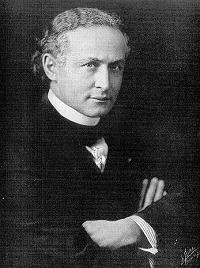
Of all Cassidy's works, this one has surely had the most
colourful history. I first began work on this feature some
years ago, following the receipt of photographs of a
bronze version (shown below) by a writer who wished to
remain anonymous, and have made several attempts to
complete it since, but struggled to get the story
straight.
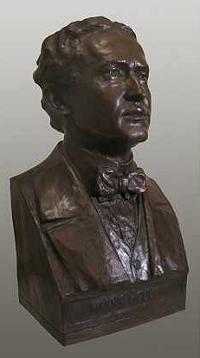
Looking for something to publish here for October 2011, I
decided to have another try, and was surprised to discover
that just two weeks earlier, at the end of September, a
whole new chapter in the story had opened up.
So here's the story of the Houdini bust, as good as we
can make it. Any comments and additions are welcome. - Charlie
Hulme
Houdini: a brief biography
Most people have probably heard of Houdini; for those who haven't, Harry Houdini (born Erik Weisz, later Ehrich Weiss) was born in Hungary in 1874 and died on October 31, 1926.
He emigrated, with his mother and brothers, to America in 1878 to join his father who was a Rabbi in Appleton, Wisconsin. In 1887 the family moved to New York, and Ehrich learned the magician's trade, adopting the name Harry Houdini and eventually specialising in 'escapology' for which he became world famous. His stage act consisted of various variations of 'impossible' escapes from boxes, handcuffs, chains, ropes, etc.
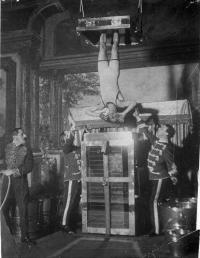
The picture above shows a typical performance, with him being lowered upside-down into a tank of water.
He performed in British theatres many times; a feature of these tours was his challenge to the public to create a box he could not escape from.
In the 1920s, he also became known as what is now called a 'sceptic', debunking fake spiritualists and mediums. He also starred in a number of films, and several biographical films and books have appeared since his death, now joined by an array of websites created by supporters.
The 1914 tour
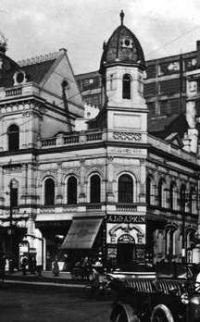
The Palace Theatre, Manchester, Circa 1914. Its facade was replaced in 1950.
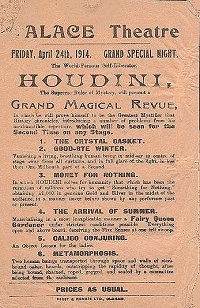
This poster is from the 1914 tour, although the Palace Theatre referred to was the one in Oldham. The Tour ran from January to June 1914: for dates, see the UK Houdini website by Mick Hanzlik.
Busts galore
There are assorted discrepancies in the history of the bust(s) as reported by the press, and the confusion is added to by comments made by James Randi in a 2008 interview in which he describes how he and a friend secretly 'kidnapped' a Houdini bust, which surely must have been a copy of the Cassidy work (even though Randi says it was by 'Church') from the Houdini Magical Hall of Fame, in Niagara Falls, Ontario, and made a partial silicone rubber mould from it (only the face, as they did not have enough material) before secretly returning it, and that many copies were made from this mould. Years later, in 1995, the Niagara building was destroyed by fire, and its bust, which was probably a plaster version, presumably destroyed.
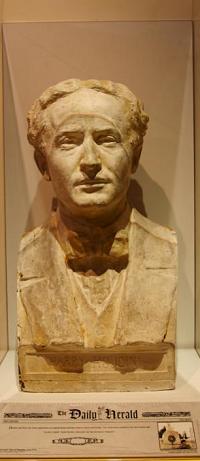
Another plaster copy (above) exists in The History Museum at the Castle, Appleton, Wisconsin, Houdini's childhood home town, as part of its comprehensive Houdini exhibit. Picture by courtesy of the museum.
The 2011 version
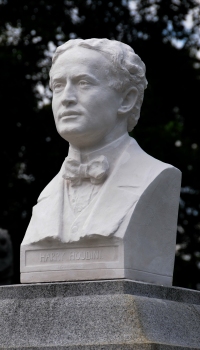
Above, the bust as mounted on the grave in 2011: see story opposite.
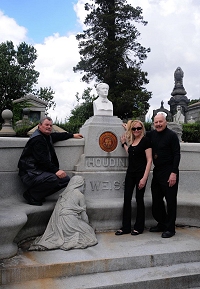
The team who replaced the bust in 2011, the Houdini Commandos: Steve Moore, Dorothy Dietrich, Dick Brookz.
Pictures by the Houdini Museum, Scranton.
Thanks to everyone who assisted with this page, including Matt Carpenter of Appleton, Wisconsin and Melanie Bower of the Museum of the City of New York, and especially the 'Houdini Commandos', Dick Brookz & Dorothy Dietrich, who were kind enough to make a number of comments which have been incorporated into the text.
So our story ends - for now. Will there be another chapter?
Harry Houdini (1914)
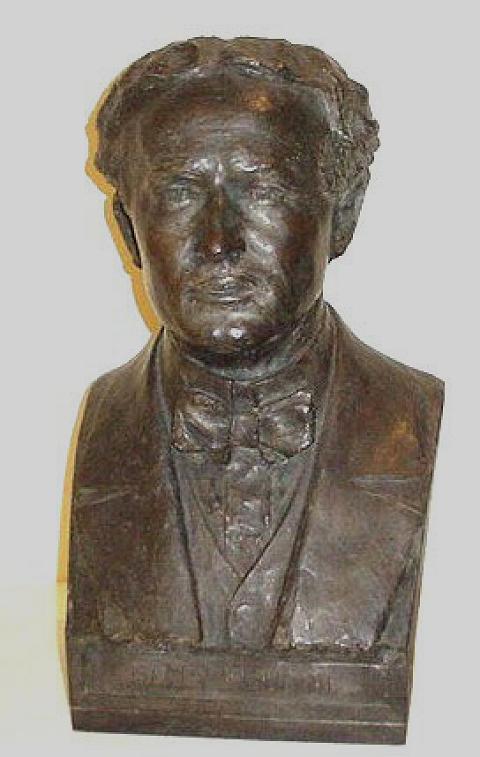
The original bronze. Picture by courtesy of the Museum of the City of New York.
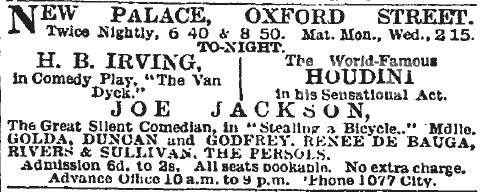
Cutting from the Manchester Guardian, 1914
We believe that the bust was modelled by Cassidy, probably at the Lincoln Grove studio, during Houdini's 1914 tour of Britain. He performed in Manchester for six nights from 23 - 28 February; the cutting above is from the Manchester Guardian of 26 February, The 'New Palace' name was adopted by the Palace of Varieties following a reconstruction of the auditorium in 1913-14; it later reverted to the name 'Palace Theatre', and as such is still in business today. How Cassidy and Houdini came to be introduced does not seem to have been recorded.
The bronze bust, now in the Museum of the City of New York and pictured above, returned with Houdini to his home in the United States; it was after his death on 31 October 1926 that its real adventures, or at least the adventures of its clones, began.
The New York Times of 12 November 1926 had a detailed report on Houdini's will, including the following:
His wishes were carried out, although the bust permanently mounted on the grave was not bronze, but a marble copy, presumably made by a local craftsman. We understand the bronze bust was brought there temporarily by Bess Houdini until the marble one was ready.
The bronze version remained with the family, until it was presented to the Museum of the City of New York in 1958 by Mr. and Mrs. John A. Hinson (Mrs Hinson was May Rahner, sister of Houdini's wife Bess Rahner); other copies were made at various times.
In 1975, the bust on the grave was smashed. According to James Randi, escapologist Norman Bigelow was involved in this destruction, using a sledge-hammer. However, he was famously a self-publicist. A credible witness has described a different series of events; after the Society of Magicians left on Halloween, locals would stay and party. The site was a 'hang out.' On the occasion in question they got up on the excedra and began to try to move the bust. It began to rock, and toppled and smashed when the bolts come loose; parts of this may exist somewhere.
It was replaced by a copy, this time made of plastic, as on 15 August 1983 the New York Times reported:
More vandalism occurred in 1993, when the whole grave was wrecked. This time, famous modern magicians, including David Copperfield and James Randi contributed to the the replacement of two granite benches and for the casting of a copy of the bust that was placed in position on the grave only at observances commemorating Houdini by the Society of American Magicians. The cemetery also contributed to restoring the family plot and prepared concrete bases for the new benches. The new bust was said to be 'made of a marble-like compound which looks exactly like the original'.
Next, on 10 March 2002, the paper reported:
''This is going to make news around the world,'' Sidney Radner, a magician and renowned Houdini expert, said from his winter home in Palm Beach, Fla. The Houdini in question is a polyethylene resin bust weighing 30 pounds and measuring about 30 inches tall. It had been keeping watch over Houdini's family grave site on Cypress Hills Street in Glendale, Queens, when it mysteriously vanished on Aug. 15, 1983. The police reported then that it had been stolen, but for nearly 19 years the disappearance went unsolved.
Last week the Nassau County police were called to the home of Stephen Chotowicky in New Hyde Park. Mr. Chotowicky, 43, had filed a complaint against his son-in-law, accusing him of stealing some tools, the police said. Detectives went to Mr. Chotowicky's two-story red-brick home on First Avenue on Friday.
It was then and only then that the ''Only and Original'' made his sensational escape. Confined in a cardboard box with just three newspapers at his disposal, Houdini the Head made himself visible to the authorities, apparently with the capable assistance of Mr. Chotowicky's falsely accused son-in-law. A spokesman for the Nassau County police, Lt. Kevin Smith, said the detectives had obtained a warrant to search Mr. Chotowicky's master bedroom after being tipped off about its unusual contents by the son-in-law.
The police revealed the recovered Houdini bust at a news conference yesterday. ''It doesn't look damaged, just kind of old and dusty,'' Lieutenant Smith said. But the authorities were offering no further explanation of this unrevealed mystery. ''I can't share with you the explanation,'' Lieutenant Smith said.
The son-in-law, who was not identified, was exonerated by the police. Mr. Chotowicky was arrested at 3 p.m. Friday on suspicion of possession of stolen property. In a mystery of its own, he was then checked into a hospital. ''He will stay there until he is fit for confinement,'' Lieutenant Smith said.
''The phone has been ringing off the hook,'' said Dr. Bruce J. Lish, the Brooklyn dentist charged with protecting the substitute bust for the society. ''The man was a master of publicity. I've been asking, 'Are you sure this isn't a stunt to gather publicity?' ''
"That's Harry for you, exclaimed John Bohannon of Wantagh, who heads the New York City chapter of the Society of American Magicians' Harry Houdini Committee. "I'm thrilled ... I'm glad he's back. I just hope that we'll be able to get it back and put it back in our archives where it belongs."
There's a discrepancy between police and magicians as to which bust was found. Police say the recovered bust is the third one erected at Harry Houdini's monument. According to police, the original Harry Houdini bust was damaged; a second one disappeared in 1975 and was never recovered; and the third one was stolen in 1983.
However, Bohannon believes the bust found in New Hyde Park could be the original copy. He said Harry Houdini had a bronze bust made of himself while alive. He added that a marble copy of that bust was placed at Harry Houdini's cemetery plot after he died, which was either stolen or destroyed in 1975.
The American Society of Magicians then borrowed the original bronze bust from a city museum and made copies of it with a gray plastic resin. One was placed on the cemetery monument and stolen in 1983, and another one was stolen in the late 1980s, Bohannon said.
The recovered bust is white, which leads Bohannon to believe it's the original, unless one of the copies was painted. "The copies were dark gray, he said. "This sounds like it was the original, stolen back in 1975."
The Houdini Commandos
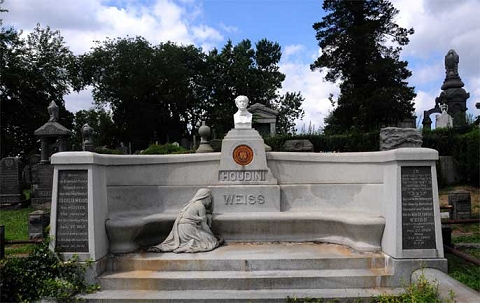
'Fast-forward' to 3 October 2011, and a press release from the Houdini Museum in Scranton, Pennsylvania:
The Houdini Museum, a 501(c)3 nonprofit museum in Scranton, PA, had a secret project to restore Houdiniís grave site bust for over 20 years. It reached full intensity in the past year. The original statuary bust was installed after Houdiniís death in 1926. It was destroyed by vandals in 1975. It has been gone for 36 years. Several composition, or plastic, busts were placed there briefly but lasted a short time or were used one day each year Ė October 31, for a ceremony done by The Society of American Magicians Ė that unfortunately brought more grief to the cemetery because of the many costumed individuals that arrived to celebrate Halloween instead of paying respect to Harry Houdini. Because of this the cemetery now closes 3 days for Halloween, the date of Houdiniís death.There are several other copies of the bust at The Houdini Museum, prototypes for the one finally installed. Several are polyurathane, one is plaster and there are two statuary cement ones. The best of three statuary cement ones is the one installed at the cemetery.
In the 1970s The Society of American Magicians made a lightweight cast of an original bust now owned by the Museum of the City of New York. Houdiniís wife donated the original to that museum. The lightweight copy was on loan in the late 1970's to magicians Dorothy Dietrich and Dick Brookz, who owned New York Cityís Magic Towne House, and had it on display to the pubic. The magicians currently run the nonprofit Houdini Museum in Scranton PA. The Society of American Magicians took back the replica in 1979 and it was soon broken again. For the sake of posterity, the two magicians made a mold of the bust and put that in storage.
In the past year Dorothy Dietrich, Dick Brookz and Steve Moore (aka Bingo), a retired escape artist, locksmith, and craftsman, made five trial composition busts and finally three statuary cement busts. The best one was destined to be installed at Houdiniís grave site. Another will be unveiled this year at the annual historic Houdini Sťance on Halloween at The Houdini Museum. This event is free and open to the public by reservation.
A secret group called the ďHoudini CommandosĒ was then formed. They were Dorothy Dietrich; Dick Brookz; Steve Moore, retired escape artist; along with Dean Allen, contractor; Tracy Bullaro, helper; Cathy Moore, helper; and Ron Chicken, videographer. The stealth plan was to get in and out unnoticed in one day.
Everything was ready. Diamond bits, drills, a powerful vacuum system, a generator (no electricity at the grave), special cements and epoxies, a way to safely transport the bust, etc. On several of the planned days flooding rains ensued and dates were changed. Everyone had to be available on the same day, which was almost impossible. Finally the day came. On September 27, 2011 everyone arrived by caravan at 10 a.m. and the work began. Each person had their assignments. Part way into the project a cemetery caretaker and watchman inquired what we were doing. Dorothy explained and tried to distract him with various papers, etc., as they continued working. The caretaker said they would have to stop until he called his boss. A long, almost non-ending phone conversation followed, and the issue of insurance came up. The Houdini Museum's insurance agent faxed a letter and they were given the go ahead. Because of the lost time and other problems, such as a powerful construction cement drying too rapidly, having to drill it out and rushing to a local hardware store last minute for more, they did not finish until 7 p.m. The watchman had now become our supporter and allowed the cemetery to stay open an extra 3 hours.
This project has cost The Houdini Museum close to $10,000, but they felt it sorely needed to be done. Houdini, in his lifetime, had paid for the fixing of dozens of magicians graves that were in disrepair. This was only fitting payback.
The 'commandos' have now become the keepers of the Houdini grave with sanction of both the Houdini family and the management of the cemetery.
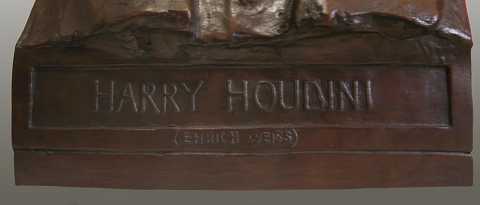
Page created by Charlie Hulme, October 2011. Updated January 2012. Update January 2025. Comments welcome.